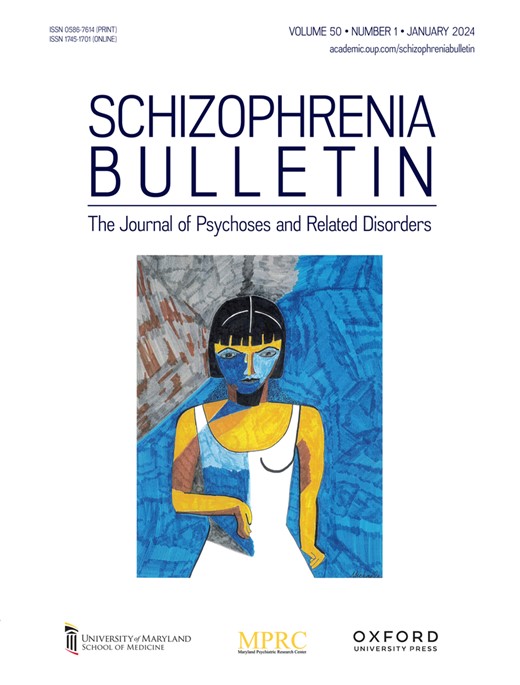探索精神病症状、认知和环境风险因素之间的相互作用:贝叶斯网络分析
IF 5.3
1区 医学
Q1 PSYCHIATRY
引用次数: 0
摘要
背景与假设 精神障碍(PDs)对个人和社会都有巨大影响,因此需要不断努力改善患者的治疗效果。环境风险因素(ERFs),尤其是可改变的风险因素,是研究的重点,因为它们是干预和预防的目标。目前还没有研究通过网络方法将环境风险因素、认知和精神病症状结合在一起进行研究。研究设计 我们探讨了 3 个重要 ERFs(吸烟、吸食大麻和童年创伤)、6 个认知领域和 3 个精神病症状维度之间的相互作用。我们从遗传风险和精神病结果(GROUP)队列中,利用患者、兄弟姐妹和健康对照组的数据,通过对所有 12 个变量的贝叶斯分析构建了网络。我们构建了综合样本的网络,并分别构建了患者和兄弟姐妹的网络。研究结果 我们发现,吸烟与认知能力和精神病性症状直接相关。认知变量处理速度是最核心的节点,它通过阳性症状和吸烟变量将精神病症状群和药物使用群连接起来。比较患者和兄弟姐妹的网络,我们发现患者和兄弟姐妹的网络相对相似。结论 我们的研究结果表明,处理速度缺陷在帕金森病中可能起着核心作用。研究结果凸显了将吸烟作为潜在ERF纳入帕金森氏症的重要性,并将视角从停止吸食大麻扩展到帕金森氏症患者或高危人群的戒烟计划。本文章由计算机程序翻译,如有差异,请以英文原文为准。
Exploring the Interactions Between Psychotic Symptoms, Cognition, and Environmental Risk Factors: A Bayesian Analysis of Networks
Background and Hypothesis Psychotic disorders (PDs) have huge personal and societal impact, and efforts to improve outcomes in patients are continuously needed. Environmental risk factors (ERFs), especially modifiable risk factors, are important to study because they pose a target for intervention and prevention. No studies have investigated ERFs, cognition, and psychotic symptoms together in a network approach. Study Design We explored interactions between 3 important ERFs (tobacco smoking, cannabis use, and childhood trauma), 6 cognitive domains, and 3 dimensions of symptoms in psychosis. From the Genetic Risk and Outcome of Psychosis (GROUP) cohort, we used data from patients, siblings, and healthy controls to construct networks using Bayesian analyses of all 12 variables. We constructed networks of the combined sample and of patients and siblings separately. Study Results We found that tobacco smoking was directly associated with cognition and psychotic symptoms. The cognitive variable processing speed was the most central node, connecting clusters of psychotic symptoms and substance use through the variables of positive symptoms and tobacco smoking. Comparing the networks of patients and siblings, we found that networks were relatively similar between patients and siblings. Conclusions Our results support a potential central role of processing speed deficits in PDs. Findings highlight the importance of integrating tobacco smoking as potential ERFs in the context of PDs and to broaden the perspective from cannabis discontinuation to smoking cessation programs in patients or people at risk of PDs.
求助全文
通过发布文献求助,成功后即可免费获取论文全文。
去求助
来源期刊

Schizophrenia Bulletin
医学-精神病学
CiteScore
11.40
自引率
6.10%
发文量
163
审稿时长
4-8 weeks
期刊介绍:
Schizophrenia Bulletin seeks to review recent developments and empirically based hypotheses regarding the etiology and treatment of schizophrenia. We view the field as broad and deep, and will publish new knowledge ranging from the molecular basis to social and cultural factors. We will give new emphasis to translational reports which simultaneously highlight basic neurobiological mechanisms and clinical manifestations. Some of the Bulletin content is invited as special features or manuscripts organized as a theme by special guest editors. Most pages of the Bulletin are devoted to unsolicited manuscripts of high quality that report original data or where we can provide a special venue for a major study or workshop report. Supplement issues are sometimes provided for manuscripts reporting from a recent conference.
 求助内容:
求助内容: 应助结果提醒方式:
应助结果提醒方式:


